Welcome Blessings!
(Tap 🔽 to see more topics!)
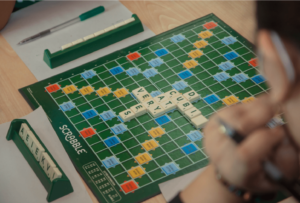

A fun game can transform the daunting task of learning English into an exciting adventure. Forget the dusty textbooks and the endless grammar drills. Imagine stepping into a world where mastering a new language feels less like work and more like play. Staring at vocabulary lists and conjugation tables can feel like an uphill battle, especially when you struggle to see the real-world value. But what if you could trade those tedious tasks for an engaging experience that makes you look forward to learning?
That’s the magic of game-based learning. It’s like turning your English lessons into a fun, interactive playground. Instead of passively absorbing information, you’re actively using it to solve puzzles, conquer challenges, and even engage in friendly competition. Remember those moments as a kid when you were completely immersed in a game and unknowingly learned something valuable? That’s the feeling we’re aiming for.
Game-based learning utilizes carefully designed games to captivate you, providing instant feedback on your progress and fostering a healthy competitive spirit. The core concept is simple: while you’re having a blast playing, your brain effortlessly absorbs English language skills, making the entire learning journey engaging and, most importantly, motivating you to progress.
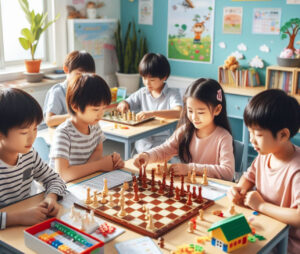
Use different types of games for game-based learning, depending on the purpose, context, and level. Some examples are:
In this article, you will learn some specific examples of games to teach different English skills, such as vocabulary, grammar, reading, writing, listening, and speaking. Also, you will learn how the game works, the learning objectives, the outcomes, and how the teacher can facilitate and assess the learning process.
Scrabble is a board game that involves forming words with letter tiles on a grid. Participants’ scores on the length and difficulty of the vocabulary they form. Players can use bonus squares on the board to multiply their scores.
You can use Scrabble to teach vocabulary related to different topics, such as animals, plants, food, clothing, colors, and shapes. Teachers can create custom word lists for the students to use during the game. For example, teachers can create word lists about animals or food for the students to practice. Or they can create word lists about clothing or colors for the students to learn new words. The learning objectives of using Scrabble for vocabulary are to:
The learning outcomes of using Scrabble for vocabulary are the following:
At the end of the lesson, the students will be able to:
The teacher’s role in using Scrabble for vocabulary is to:
It is a card game that involves asking and answering questions about cards in one’s hand or a pile. Players try to gather groups of four cards of the exact level by asking other players if they have them. If they do, they give them to the asker. However, if they don’t, they say, “Go fish,” and the one who asks pulls a card from the pile.
GoFish can be used to teach grammar rules and patterns interactively. Teachers can create custom cards with different grammar topics, such as verb tenses, noun genders, sentence structures, and word order. For example, teachers can create cards with verbs in different tenses for the students to practice. Or they can make cards with nouns of different genders for the students to learn.
The learning objectives of using Go Fish for grammar are to:
The learning outcomes of using Go Fish for grammar are:
The teacher’s role in using Go Fish for grammar is to:
Pictionary is a board game that involves drawing and guessing words or phrases. Players take turns illustrating words or phrases while their teammates try to identify the hidden meanings. The group with the highest score at the end of the match wins.
Pictionary can be used to teach reading comprehension and analysis skills in a fun and engaging way. Teachers can create custom cards with different texts, such as narratives, descriptions, instructions, letters, and reviews. For example, teachers can create cards with stories for the students to draw and guess. Or they can make cards with instructions or reviews for the students to read and follow.
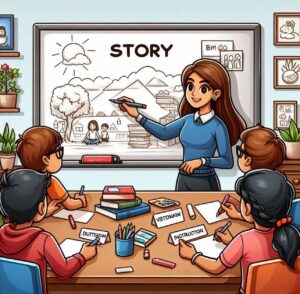
The learning objectives of using Pictionary for reading are to:
The learning outcomes of using Pictionary for reading are:
At the end of the lesson, the students can:
The teacher’s role in using Pictionary for reading is to:
Charades is a game that involves acting out words or phrases without speaking. Players alternately act out a word or phrase on a card while their teammates try to guess what it is. The team that scores the most points by correctly playing a hunch of words or phrases wins.
Teachers can use the game as a stimulus for various writing tasks, such as narratives, descriptions, instructions, letters, and reviews. For instance, lecturers can request students to write a story about the word or phrase they acted out, a description of how they acted it out, an instruction manual for playing the game, a letter from one player to another, or a review of the game.
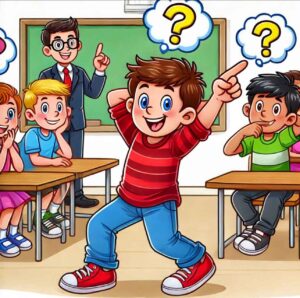
The learning objectives of using Charades for writing are:
At the end of the lesson, the students can:
The teacher’s role in using Charades for writing is to:
20 Questions is a game that involves asking and answering yes or no questions about an object or a person. One player is the “thinker,” and the other players are the “guessers.” The thinker chooses an object or person, and the guessers try to guess what it is by asking up to 20 questions. The player who thinks of the object or person can only answer yes or no.
Moreover, you can use it to teach listening skills socially and interactively. Teachers can use the game as an opportunity for students to practice listening for different purposes, such as information, persuasion, and entertainment. For example, teachers can ask students to listen for clues about the object or person, for arguments about why they should choose the questions, or listen for jokes and reactions from other players.
The learning objectives of using 20 Questions for listening are to:
At the end of the lesson, the students can:
The teacher’s role in using 20 Questions for listening is to:
Guess Who is a board game that involves asking and answering questions about people’s appearance. Each player has a board with 24 faces of different people with different features. Each player also chooses one secretly. Participants take turns to ask yes or no questions about the other player’s chosen face, such as “Does your person have glasses?” or “Is your person bald?”. The aim is to guess the other player’s face before they identify yours.
Playing the Guess Who game is an excellent method to enhance one’s speaking abilities in a fun and effortless way. This game encourages players to describe various characteristics of the characters on the board, such as their physical appearance, clothing, and accessories. It not only improves one’s speaking skills, but it also helps to expand vocabulary, develop logical thinking, and stimulate creativity.
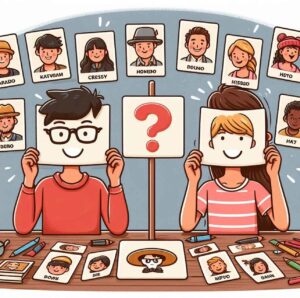
The Guess Who game is valuable for anyone looking to enhance their communication skills. Educators can use the game to introduce vocabulary related to physical appearances, such as hair, eyes, nose, mouth, ears, glasses, hat, beard, and mustache. Teachers can also use the game to teach grammar related to questions, such as word order, question words, and auxiliary verbs. For example, teachers can ask students to form questions using “do,” “does,” “is,” or “are.”
The learning objectives of using Guess Who for speaking are to:
At the end of the lesson, the students can:
The teacher’s role in using Guess Who for speaking is to:
To sum it up, we’ve taken a peek into how turning English lessons into a fun game can shake things up. It’s not just about playing for the sake of playing… it’s about making learning stick. We’ve also discussed how games can pump up the excitement, make tricky concepts click, and give everyone a real sense of accomplishment.
Of course, like any good adventure, there are a few bumps in the road. Finding the right games, ensuring they fit with what you’re teaching, keeping the class on track, and seeing if everyone’s learning is a bit like being a game master! But with a little planning and a dash of creativity, you can make it happen.
Remember those key points we went over? Choose games your students will love, make sure they tie into your lesson goals, guide them through the game, keep an eye on their progress, give helpful feedback, and check how much they’ve learned. It’s like building a team for a quest – everyone must know their role. Ultimately, game-based learning is about making English feel less like a stuffy subject and more like a thrilling experience. It’s about showing students that learning can be joyful and engaging. Honestly, isn’t that what we all want?
If you’re feeling inspired to bring a little more play into your English classroom or have your own game-based learning stories to share, jump into the comments below! Drop a comment below about how we can make learning English an adventure everyone looks forward to. And if you’re ready to explore this exciting world further, why not incorporate a simple game into your next lesson and see the difference for yourself? You might be surprised at how much fun learning can be. Voila! Until next time!
Additional References/ Further Readings:
Robb, K. (2021, September 21). Using social media to engage students. Cambridge English. https://www.cambridge.org/elt/blog/2021/09/21/using-social-media-engage-students/
Davis, V. (2015, February 27). A guidebook for social media in the classroom. Edutopia. https://www.edutopia.org/blog/guidebook-social-media-in-classroom-vicki-davis